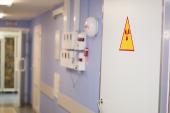PCI Radiation Reduction Intervention Scores Big in Michigan
An “aggregate of multiple individual changes” likely helped drive down radiation doses, an editorial suggests.

A statewide effort to get hospitals in Michigan to lower their procedural radiation levels for PCI resulted in a steady decrease over a 6-year period, new data show.
“We were really pleased to see these declines going from a median dose in 2016 of 1.46 [Gy], down to a median dose in the last year of the study of 0.97 [Gy],” lead author Ryan D. Madder, MD (Corewell Health Grand Rapids Hospitals Fred & Lena Meijer Heart Center, Grand Rapids, MI), told TCTMD.
In a prior study, Madder and colleagues had found wide variation in the percentage of PCI procedures with an air kerma (AK) ≥ 5 Gy across a large hospital registry in Michigan. After that study was published, the Blue Cross Blue Shield of Michigan Cardiovascular Collaborative (BMC2) added PCI procedural radiation dose as a performance metric for all institutions.
“In our [prior] study, there were some hospitals where more than 10% of their PCI doses were more than 5 Gy, and that was really alarming to us,” Madder said.
Hospitals enrolled in the BMC2 consortium were given a goal of less than 2% of all their cases having an air kerma of more than 5 Gy, a radiation dose threshold above which guidelines suggest that patients be counseled about the risk of radiation-induced skin injury.
During the study period, which ran through June 30, 2022, the percentage of PCI cases with an AK ≥ 5 Gy declined from 4.24% in the first year to 0.86% in the last year (P < 0.0001 for trend).
“The cath lab directors deserve a lot of credit for this because they took the education that we provided at our quarterly meetings back to their cath labs and really were the ones that enacted change,” Madder said.
In an editorial accompanying the study, Stephanie S. Colello, MD (Hospital of the University of Pennsylvania, Philadelphia), and colleagues note that with each year increment, there was a 7% mean reduction in radiation exposure per procedure. They cite this as “remarkable” given that procedure complexity, including left main PCI, atherectomy, and PCI performed with mechanical circulatory support, increased over that same time period, as did fluoroscopy times.
“The causes of the observed dose reduction are likely due to an aggregate of multiple individual changes that fall into two general categories that have common properties: decreased X-ray dose per pulse to the image detector and decreased X-ray pulse frequency,” Colello and colleagues write.
The cath lab directors deserve a lot of credit for this. Ryan D. Madder
They add that hospitals can accomplish this through upgrades or replacements to their X-ray systems as well as through “conscious adjustment of X-ray exposure parameters by the operator.”
Training and Motivation Are Key
The study, published this week in Circulation: Cardiovascular Interventions, examined radiation practices for 131,619 PCI procedures at 28 hospitals enrolled in the BMC2 registry.
In addition to the decline in cases with AK ≥ 5 Gy, the researchers also saw declines in cases with AK ≥ 2 Gy, from 33.34% in year 1 to 17.02% in year 6 (P < 0.0001). During the same time period, median fluoroscopy time increased from 13.7 to 16.2 minutes (P < 0.001 for trend).
Looking at the frequency of procedural AK ≥ 5 Gy at the institutional level, there was a range from 0 to 10.9% of PCI procedures in the first 21 months of the study, which shifted to a range of 0 to 3.1% of PCI procedures by the end of the study.
“So, the hospital with the highest frequency at the end of this study had only 3% of their cases with high doses compared to more than 10% when we started,” Madder said. “For any hospital who's interested in creating a safer radiation culture, the first step may be understanding how frequently you are having high doses and focus on lowering that frequency.”
According to Colello and colleagues, while modernization of X-ray equipment probably helped in some capacity to minimize radiation, the onus is on the physician operator to practice dose-sparing techniques during PCI, adding that the Michigan collaborative included operator education on adjusting X-ray system exposure parameters to reduce dose.
“These adjustments are facilitated by the tableside exposure controls built into current generation systems,” they write. “The potential of these exposure reduction modalities, while substantial, can be realized only if the physician operators are fully trained in their application and are motivated to employ them.”
Madder said the takeaway for all is that there are always things that can be done to lower radiation doses even further, but whether other states can replicate the results seen in Michigan remains to be seen.
“This is a field in evolution and we're going to continue to see these doses come down over years with better technology and refinement and development of devices that help keep our patients safer, physicians safer, and our staff safer,” he added.
L.A. McKeown is a Senior Medical Journalist for TCTMD, the Section Editor of CV Team Forum, and Senior Medical…
Read Full BioSources
Madder RD, Seth M, Frazier K, et al. Statewide initiative to reduce patient radiation doses during percutaneous coronary intervention. Circ Cardiovasc Interv. 2024;17:e013502.
Colello SS, Fiorilli PN , MD; Hirshfeld JW Jr. Old dogs can learn new tricks: reducing radiation exposure in the cardiac catheterization laboratory. Circ Cardiovasc Interv. 2024;17:e013846.
Disclosures
- Madder reports having received speaker honoraria from Abbott Vascular, Corindus, and Infraredx; having served as a consultant to Abbott Vascular, Angiowave Imaging, Corindus, Infraredx, and SpectraWAVE; having received research support from Corindus and Infraredx; and serving on the advisory boards of Medtronic and SpectraWAVE.
- Colello reports no relevant conflicts of interest.





Comments